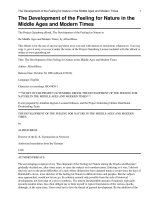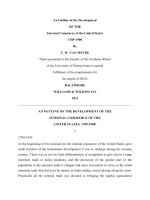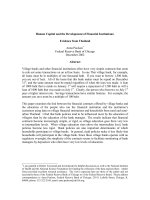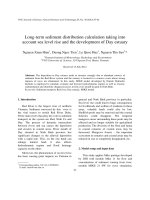- Trang chủ >>
- Khoa Học Tự Nhiên >>
- Vật lý
the development of persistent criminality feb 2009
Bạn đang xem bản rút gọn của tài liệu. Xem và tải ngay bản đầy đủ của tài liệu tại đây (2.8 MB, 561 trang )
THE DEVELOPMENT OF PERSISTENT
CRIMINALITY
This page intentionally left blank
e Development of
Persistent Criminality
Edited by
Joanne Savage
1
3
Oxford University Press, Inc., publishes works that further
Oxford University’s objective of excellence
in research, scholarship, and education.
Oxford New York
Auckland Cape Town Dar es Salaam Hong Kong Karachi
Kuala Lumpur Madrid Melbourne Mexico City Nairobi
New Delhi Shanghai Taipei Toronto
With o ces in
Argentina Austria Brazil Chile Czech Republic France Greece
Guatemala Hungary Italy Japan Poland Portugal Singapore
South Korea Switzerland ailand Turkey Ukraine Vietnam
Copyright © by Oxford University Press, Inc.
Published by Oxford University Press, Inc.
Madison Avenue, New York, New York
www.oup.com
Oxford is a registered trademark of Oxford University Press
All rights reserved. No part of this publication may be reproduced,
stored in a retrieval system, or transmitted, in any form or by any means,
electronic, mechanical, photocopying, recording, or otherwise,
without the prior permission of Oxford University Press.
Library of Congress Cataloging-in-Publication Data
e development of persistent criminality / edited by Joanne Savage.
p. cm.
Includes bibliographical references and index.
ISBN ----
. Recidivists. . Criminology. . Crime. . Criminals.
I. Savage, Joanne.
HV.D
.—dc
Printed in the United States of America
on acid-free paper
is book is dedicated to my grandmother, Betty Savage, who has been an
inspiration and a friend to me and to countless others.
This page intentionally left blank
vii
PREFACE
is book was inspired by the desire to learn more about the development of
persistent criminality. As the editor, I must acknowledge that it would not
have been possible to compile this book without the authors, who so will-
ingly shared their work. I wish to express my profound appreciation to them.
I would also like to thank, separately, Linda Pagani for her advice throughout
the process, and my friends, “Bry and Cyn” (Bryan Vila and Cyn Morris), for
their years of mentoring on writing and publishing. Finally, I must thank my
editors, Lori Handelman and Jennifer Rappaport at Oxford University Press,
for their interest in the project, their counsel and wisdom, and their patience.
ey were both a delight to work with and provided friendly encouragement
and support throughout the process.
This page intentionally left blank
ix
CONTENTS
Contributors xiii
Chapter Understanding Persistent O ending: Linking Developmental
Psychology with Research on the Criminal Career
Joanne Savage
Part I e Family, Poverty, and Stressful Life Events
Chapter e In uence of Family Context on the Development
and Persistence of Antisocial Behavior
Linda S. Pagani
Chapter e Implications of Family Poverty for a Pattern
of Persistent O ending
Carter Hay and Walter Forrest
Chapter Strain, Social Support, and Persistent Criminality
Stephanie Ellis and Joanne Savage
Chapter Developmental Trajectories, Stressful Life Events,
and Delinquency
Timothy O. Ireland, Craig J. Rivera, and John P. Ho mann
Chapter e E ects of Family on Children’s
Behavioral Di culties
Paul Millar
x
Part II Biosocial In uences on Persistent Criminality
Chapter Biological Factors and the Development
of Persistent Criminality
Patrick Sylvers, Stacy R. Ryan, S. Amanda Alden,
and Patricia A. Brennan
Chapter A Systematic Approach to Understanding Human
Variability in Serious, Persistent O ending
John Paul Wright and Kevin M. Beaver
Chapter Perinatal and Developmental Determinants of Early Onset
of O ending: A Biosocial Approach for Explaining the
Two Peaks of Early Antisocial Behavior
Stephen G. Tibbetts
Part III Special Topics and Populations
Chapter Interdisciplinary Perspectives on Persistent Female
O ending: A Review of eory and Research
Asha Goldweber, Lisa M. Broidy, and Elizabeth Cau man
Chapter Foster Care Youth: Aging Out of Care
to Criminal Activities
Mary Ann Davis
Chapter Educational Achievement among Incarcerated
Youth: Post-Release Schooling, Employment,
and Crime Desistance
omas G. Blomberg, William D. Bales,
and Courtney A. Waid
Part IV Methodology for Understanding the
Criminal Career
Chapter Methodological Issues in the Study
of Persistence in O ending
Alex R. Piquero
Chapter Group-Based Trajectory Modeling of Externalizing Behavior
Problems from Childhood through Adulthood: Exploring
Discrepancies in the Empirical Findings
Manfred H.M. van Dulmen, Elizabeth A. Goncy,
Andrea Vest, and Daniel J. Flannery
xi
Contents
Chapter Sanction reats and Desistance from Criminality
KiDeuk Kim
Part V Conceptualizing the Persistent O ender
Chapter Serious Juvenile O enders and Persistent Criminality
Rudy Haapanen, Lee Britton, Tim Croisdale, and
Branko Coebergh
Chapter Reconsidering Gottfredson and Hirschi’s General eory
of Crime: Linking the Micro- and Macro-Level
Sources of Self-Control and Criminal Behavior
over the Life Course
Travis C. Pratt
Chapter A Dynamic Developmental Systems Approach to
Understanding O ending in Early Adulthood
Deborah M. Capaldi and Margit Wiesner
Chapter What Drives Persistent O ending? e Neglected and
Unexplored Role of the Social Environment
Per-Olof H. Wikström and Kyle Treiber
Part VI Conclusions
Chapter What We Have Learned? Directions for Future
Research and Policy
Joanne Savage
References
Author Index
Subject Index 536
This page intentionally left blank
xiii
CONTRIBUTORS
S. A A
Department of Psychology
Emory University
W D. B
School of Criminology and Criminal
Justice
Florida State University
K M. B
College of Criminology and Criminal
Justice
Florida State University
T G. B
School of Criminology and Criminal
Justice
Florida State University
P A. B
Department of Psychology
Emory University
L B
Juvenile Research Branch, O ce
of Research
California Department of Corrections
and Rehabilitation
L M. B
Department of Sociology
University of New Mexico
D M. C
Oregon Social Learning Center
Eugene, OR
E C
Department of Psychology and Social
Behavior
University of California, Irvine
B C
Juvenile Research Branch, O ce
of Research
California Department of Corrections
and Rehabilitation
T C
Juvenile Research Branch, O ce
of Research
California Department of Corrections
and Rehabilitation
M A D
Department of Sociology
Sam Houston State University
xiv
S E
Department of Sociology
Marymount University
D J. F
Institute for the Prevention of Violence
Kent State University
W F
College of Criminal Justice
Northeastern University
A G
Department of Psychology and
Social Behavior
University of California, Irvine
E A. G
Department of Psychology
Kent State University
R H
Juvenile Research Branch, O ce
of Research
California Department of Corrections
and Rehabilitation
C H
College of Criminology and Criminal
Justice
Florida State University
J P. H
Department of Sociology
Brigham Young University
T O. I
Department of Criminal Justice
Niagara University
KD K
O ce of Justice Research and Performance
NYS Division of Criminal Justice Services
P M
Department of Community
Health Sciences
Brock University
L S. P
École de psychoéducation
Université de Montréal, Canada
A R. P
Department of Criminology
and Criminal Justice
University of Maryland
T C. P
School of Criminology and Criminal
Justice
Arizona State University
C J. R
Department of Criminal Justice
Niagara University
S R. R
Department of Psychology
Emory University
J S
Department of Justice, Law and Society
American University
P S
Department of Psychology
Emory University
S G. T
California State University
San Bernardino
K T
Institute of Criminology
Cambridge University
xv
Contributors
M H. M. D
Department of Psychology
Kent State University
A V
Department of Psychology
Kent State University
C A. W
School of Criminology and Criminal
Justice
Florida State University
M W
Department of Educational
Psychology
University of Houston
P-O H. W
Institute of Criminology
Cambridge University
J P W
Division of Criminal Justice
University of Cincinnati
This page intentionally left blank
THE DEVELOPMENT OF PERSISTENT
CRIMINALITY
This page intentionally left blank
CHAPTER
Understanding Persistent O ending: Linking
Developmental Psychology with Research
on the Criminal Career
J S
at serious and violent criminal behavior does not arise anew or seren-
dipitously is among the core assumptions of most delinquency theories and
is primary justi cation for early identi cation e orts and related preven-
tion activities. Whether the belief is that such behavior is the expression of
an unfolding predisposition, training, or the culmination of neurological,
psychological, and social damage to the child, there is an assumption that
such behavior develops in some ordered fashion (Tolan & Gorman-Smith,
, p. ).
Persistent and Chronic O ending
We now know that a small percentage of individuals, whom we refer to
as “chronic o enders,” are responsible for about half of all the crime that
is committed (e.g., Petersilia, ; Piper, ; Piquero, a; Tracy,
Wolfgang, & Figlio, ). More than two decades ago, this nding inspired
a new approach to the eld of criminology: examining “criminal careers.”
In recent years, research in this area has focused on the “life course” per-
spective, the criminal trajectories of o enders, and tests of Mo tt’s ()
“adolescence-limited” and “life-course-persistent” typology. e emphasis
has been on distinguishing various types of o ending trajectories, methodo-
logical issues for doing this type of analysis, and debating some foundational
issues, such as the nature of the age-crime curve and the necessity of longitu-
dinal research.
Meanwhile, in the world of child development, researchers have pro-
duced voluminous documentation on the risk factors for conduct disorders
and aggression. There are many longitudinal studies, well-informed about
the stages of early life and concepts such as “attachment” which psycholo-
gists believe are important for healthy development. In some cases our
fields combine and “developmental criminologists” examine the risk fac-
tors for delinquency and criminal behavior. Studies such as the Cambridge
Study in Delinquent Development (e.g., Farrington, ), the Pittsburgh
Youth Study (e.g., Loeber et al., ), the Danish Longitudinal Study
(Kyvsgaard, ), the Dunedin Longitudinal Study (e.g., Henry, Caspi,
Moffitt, & Silva, ), the Montreal Longitudinal-Experimental Study
(e.g., Haapasalo & Tremblay, ), the National Youth Survey (Elliott,
), the Oregon Youth Study (e.g., Capaldi & Patterson, ), and the
Seattle Social Development Project (Hawkins et al., ) among others
have generated an enormous amount of empirical data that has revealed
dozens of developmental correlates of criminal offending such as maternal
age and marital status, parenting styles, school achievement, attachment
and attainment, harsh discipline and child abuse, and association with
delinquent peers.
Yet, while we have come to understand ways of looking at criminal
o ending over time, and we know of many risk factors for aggression and
delinquency, it is not clear which factors lead speci cally to the persistent
and serious patterns of criminality that cause so much harm to society. In
short, we know there are chronic o enders, and generally agree on many
of the risk factors for o ending, but we have not yet established which of
these risk factors apply to persistent and serious o ending in particular. e
inspiration for the present book was to bring together scholars from both
criminology and developmental psychology to forward our understanding
of the development of persistent criminality. In the present chapter, I review
some of the related literature to set the context and tone for the rest of the
chapters.
Understanding Persistent O ending
Risk Factors for Conduct Disorders,
Aggression, and Delinquency
It is beyond the scope of this chapter to review the enormous literature on the
risk factors for conduct disorder, aggression, and delinquency in its entirety.
I limit my discussion to those that I believe are likely candidates for risk
factors for persistent o ending.
Personal Risk Factors
Stability of Antisocial Behavior: e Aggressive “Trait”
As Patterson () has pointed out, stability of aggression is now “part of
the conventional wisdom” (p. ), though the nature of antisocial behavior
changes over time. Reviewers in the eld of developmental psychology have
been concluding for decades that aggression is a stable behavioral character-
istic, though Tolan and Gorman-Smith () point out that high coe cients
may re ect the high stability of the nonaggressive majority of subjects included
in the computations. Patterson’s () ndings provide evidence that a child-
hood trait for antisocial behavior “is highly stable over a ve-year interval”
(p. ). Longitudinal studies uniformly report signi cant correlations between
current and past aggressive, conduct-disordered, and delinquent behavior in
many forms. Authors of virtually all the major, recent, longitudinal studies on
criminality report evidence for continuity.
It is not surprising to nd that personality traits demonstrate continuity
over time. Morizot and Le Blanc () found evidence for stability in person-
ality characteristics associated with antisocial behavior including authority
opposition, mistrust, anxiousness, negative emotionality, tough-mindedness
and others. Kim-Cohen et al. () found that most adults with mental
disorders in their sample had been diagnosed with a mental disorder by age
and about half or more by age , suggesting substantial continuity in a variety
of mental and behavioral problems.
ere is less consensus about the continuity of antisociality among girls.
For example, Stattin and Magnusson () found early adolescent aggres-
siveness was associated with adult delinquency for boys but not girls in their
Swedish sample. Broidy, Cau man et al. () also found no association
between childhood physical aggression and adolescent o ending among girls.
Landsheer and van Dijkum () found that middle (but not early) delin-
quency predicted late adolescent delinquency for girls.
e explanations for stability can be categorized, broadly, into three
groups. Some authors emphasize an aggressive character trait that is likely
to be due, in part, to genetic and biological factors (e.g., Botha & Mels, ;
Walters, ). (Some authors emphasize a trait, such as low self-control,
but de-emphasize biology and focus on early-childhood socialization; e.g.,
Gottfredson & Hirschi, ; Robins & Ratcli , .) Many authors have
proposed or reported that “trait” characteristics are likely to be associated
with the development of persistent conduct problems (e.g., Mo tt, ;
Nagin & Farrington, a). Farrington () found that personality charac-
teristics such as daring and low intelligence were characteristic of delinquents
in his sample. Lahey et al. () propose that a single latent construct of
antisocial propensity exists; it has multiple causal sequences that begin with
temperamental factors such as oppositional temperament, harm avoidance,
and callousness. Farrington () also came to believe, a er analyzing the
Cambridge data, that a larger syndrome of antisocial tendency exists.
A second reason for stability is consistency in the environment that elic-
its the antisocial behavior (Patterson, Reid, & Dishion, ). Ongoing rela-
tionships with delinquent peers, residence in a high-crime neighborhood,
exposure to criminal family members are likely to lead to criminal activity,
regardless of individual propensity. Because these endure over time, so will
antisocial behavior.
Finally, some emphasize reciprocal relationships between past behavior, its
consequences, and future behavior. For example, Laub and Sampson ()
maintain that prior antisocial behavior sets the context for future behavior
by, for example, severing social bonds, causing job loss, harming intimate
relationships or resulting in criminal justice interventions. Antisocial behav-
ior may also interrupt education or work life. Vila () would argue that
the interplay is one step deeper. Not only do situations frame criminal activ-
ity, but individuals develop “strategic styles” resulting from the di erential
reinforcement of past behavior. In individuals faced with sti ing situational
constraints, habits of using force, fraud, or stealth may evolve. Wright et al.
() propose an interaction; based on the “life-course interdependence”
view, the authors argue that prosocial ties like education and antisocial ties
like association with deviant peers are likely to have a greater in uence on
those high in criminality.
Of course, many authors have come to believe that stability is due to com-
binations of these causes. Wiesner et al. () detail three processes that are
related to persistent patterns of o ending: coercive behavior patterns, develop-
mental failures (o en due to these behavior patterns), and ongoing exposure
to contexts conducive to o ending (such as associating with deviant peers or
becoming involved with an antisocial partner).
Understanding Persistent O ending
In spite of signi cant evidence for stability, it is still the case that most
individuals who commit delinquent acts in their youth do not become seri-
ous persistent o enders. Werner and Smith () found that while a retro-
spective analysis showed that of males arrested for a criminal o ense as
an adult had a delinquent record, a prospective analysis revealed that only
of male delinquents were convicted of adult crimes. Similar observa-
tions have been made by Robins () who noted that while most antisocial
children recover, “. . . severe adult antisocial behaviour does seem virtually
to require a history of antisocial behaviour in childhood” (p. ). So under-
standing more about the particular biological predispositions, situations,
behaviors, and consequences that contribute to the development of the stable
pattern would be useful for our goal (For a discussion of psychopathy, related
to the issue of antisocial “traits,” see Chapter ).
Cognitive Abilities. ere is signi cant evidence, going back many decades,
that low intelligence is partly due to neurobiology and is associated with
delinquent and criminal behavior (for an excellent, detailed discussion, see
Nigg & Huang-Pollock, ; also see Chapter , for discussions of neurobiol-
ogy, executive functions, and various chronic antisocial behaviors). In recent
years, researchers have focused their attention on the association between
criminality and de cits in verbal abilities (e.g., Henry & Mo tt, ; Mo tt,
Caspi, Silva, & Stouthamer-Loeber, ) and the discrepancy between verbal
and performance IQ (e.g., Cornell & Wilson, ; Walsh, Petee, & Beyer, ).
Studies commonly discover very low IQ scores among incarcerated o end-
ers. For example, Hollander and Turner () found that of consecutively
admitted incarcerated male juvenile o enders had IQ scores between and .
With regard to longitudinal relationships, in the Cambridge Study in
Delinquent Development, one of the most important childhood predictors of
adult antisociality was having low intelligence (Farrington, ). Hechtman
et al. () found that IQ predicted the number of o enses committed
over a -year follow-up. Data from a Danish longitudinal study indicate a
correlation between childhood IQ scores and arrests in young adulthood
(Wallander, ). Sampson and Laub () found a signi cant negative rela-
tionship between juvenile IQ and adult criminal activity in their analysis of
the supplemented Unraveling Juvenile Delinquency dataset (e.g., Glueck &
Glueck, ).
Attention De cit and Low Self-Control. One view of the “personality”
issue came to the forefront in criminological theory with the publication
of A general theory of crime by Gottfredson and Hirschi (). e authors
argue that low self-control constitutes a persistent trait that results when there
are de ciencies in socialization in early life (for more on Gottfredson and
Hirschi’s theory and low self-control, see Chapter ).
ere is signi cant evidence supporting the hypothesis that low self-
control or related characteristics such as attention de cit disorder (ADD)
are associated with criminal behavior. Studies of “behavioral activation”
(hyperactivity) and behavioral disinhibition suggest that they are longitudi-
nally related to later delinquency (Tremblay & LeMarquand, ). Satter eld
et al. () compared a group of children diagnosed with ADD to a group
of matched controls. At follow-up, signi cantly more subjects from the ADD
group had been arrested. Hyperactivity and emotional stability measured at
ages to has been related to o enses measured years later (Hechtman,
Weiss, Perlman, & Amsel, ).
Lahey and Loeber () point out that, while several prospective lon-
gitudinal studies report that children with attention-de cit/hyperactivity
disorder (ADHD) exhibit antisocial behavior later in life, the analyses do not
control for other conduct disorders. Because attention problems are o en
found in children with conduct disorder, for example, they concluded, at that
time, that studies of the independent e ect of ADHD had “failed to provide
an unambiguous answer to this question” (p. ). More recent studies have
also provided mixed ndings. Wallander () did not nd a relationship
between attention problems in males ages to and cumulative arrest fre-
quency years later, controlling for IQ and father’s alcohol problems. Broidy,
Nagin et al. () controlled for other disruptive behaviors and found that
hyperactivity did not have an independent e ect on criminal outcomes.
A meta- analysis of empirical tests of the general theory by Pratt and Cullen
() suggests that while low self-control is an important predictor of crimi-
nal behavior, its e ects are weak in longitudinal studies.
Other Biological Factors. ere is a vast literature on the e ects of various
genetic, neurobiological, and psychophysiological factors on aggression, con-
duct problems and criminal behavior. Most authors agree that such factors are
less likely to have important direct e ects than they are to in uence antiso-
ciality indirectly, through their impact on the development of self-control,
executive functions, and verbal abilities, for example, which may in turn a ect
opposition, attention, hyperactivity, and aggression (Tremblay & LeMarquand,
). Pre- and perinatal insults may also impair social skill acquisition and
bring about peer rejection. For example, they may cause impairment in the
ability to read facial expressions or increase behavioral problems such as
impulsivity (Brennan, Grekin, & Mednick, ).
Many studies aggregate factors into measures of neurophysiological risk
or neuropsychological pro les and these measures are o en associated with
delinquency. Mo tt et al. (), for example, found that age neuropsycho-
logical scores predicted later delinquency. Because the realm of factors that
can in uence these developments is quite large, it would be di cult to list









